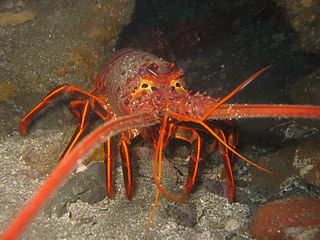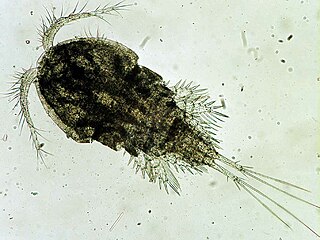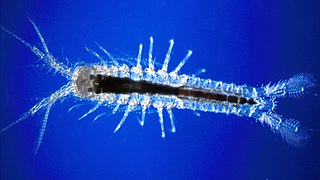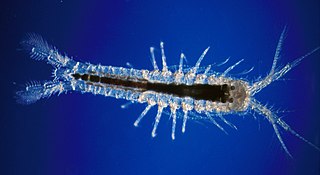
Spiny lobsters, also known as langustas, langouste, or rock lobsters, are a family (Palinuridae) of about 60 species of achelate crustaceans, in the Decapoda Reptantia. Spiny lobsters are also, especially in Australia, New Zealand, Ireland, South Africa, and The Bahamas, called crayfish, sea crayfish, or crawfish, terms which elsewhere are reserved for freshwater crayfish.

Copepods are a group of small crustaceans found in nearly every freshwater and saltwater habitat. Some species are planktonic, some are benthic, a number of species have parasitic phases, and some continental species may live in limnoterrestrial habitats and other wet terrestrial places, such as swamps, under leaf fall in wet forests, bogs, springs, ephemeral ponds, puddles, damp moss, or water-filled recesses of plants (phytotelmata) such as bromeliads and pitcher plants. Many live underground in marine and freshwater caves, sinkholes, or stream beds. Copepods are sometimes used as biodiversity indicators.

Tantulocarida is a highly specialised group of parasitic crustaceans that consists of about 33 species, treated as a class in superclass Multicrustacea. They are typically ectoparasites that infest copepods, isopods, tanaids, amphipods and ostracods.

Amphipoda is an order of malacostracan crustaceans with no carapace and generally with laterally compressed bodies. Amphipods range in size from 1 to 340 millimetres and are mostly detritivores or scavengers. There are more than 9,900 amphipod species so far described. They are mostly marine animals, but are found in almost all aquatic environments. Some 1,900 species live in fresh water, and the order also includes the terrestrial sandhoppers such as Talitrus saltator.

Leptostraca is an order of small, marine crustaceans. Its members, including the well-studied Nebalia, occur throughout the world's oceans and are usually considered to be filter-feeders. It is the only extant order in the subclass Phyllocarida. They are believed to represent the most primitive members of their class, the Malacostraca, and first appear in the fossil record during the Cambrian period.

The Cyclopoida are an order of small crustaceans from the subclass Copepoda. Like many other copepods, members of Cyclopoida are small, planktonic animals living both in the sea and in freshwater habitats. They are capable of rapid movement. Their larval development is metamorphic, and the embryos are carried in paired or single sacs attached to first abdominal somite.

Sea lice are copepods of the family Caligidae within the order Siphonostomatoida. They are marine ectoparasites that feed on the mucus, epidermal tissue, and blood of host fish. The roughly 559 species in 37 genera include around 162 Lepeophtheirus and 268 Caligus species.

Cumacea is an order of small marine crustaceans of the superorder Peracarida, occasionally called hooded shrimp or comma shrimp. Their unique appearance and uniform body plan makes them easy to distinguish from other crustaceans. They live in soft-bottoms such as mud and sand, mostly in the marine environment. There are more than 1,500 species of cumaceans formally described. The species diversity of Cumacea increases with depth.

Poecilostomatoida are an suborder of copepods. Although it was previously considered a separate order, recent research showed it to be nested within the Cyclopoida

Palaemonidae is a family of shrimp in the order Decapoda. Many species are carnivores that eat small invertebrates, and can be found in any aquatic habitat except the deep sea. One significant genus is Macrobrachium, which contains commercially fished species. Others inhabit coral reefs, where they associate with certain invertebrates, such as sponges, cnidarians, mollusks, and echinoderms, as cleaner shrimps, parasites, or commensals. They generally feed on detritus, though some are carnivores and hunt tiny animals.

Mictocaris halope is the only species of cave crustacean in the monotypic genus Mictocaris. It is placed in its own family, Mictocarididae, and is sometimes considered the only member of the order Mictacea. Mictocaris is endemic to anchialine caves in Bermuda, and grows up to 3.5 mm (0.14 in) long. Its biology is poorly known.

Mictacea is a monotypic order of crustaceans. It was originally erected for three species of small shrimp-like animals of the deep sea and anchialine caves. They were placed in two families, the Mictocarididae and Hirsutiidae, but Hirsutiidae is now placed in order Bochusacea, leaving Mictacea with a single species, Mictocaris halope.
Edriophthalma is a disused peracarid (Malacostraca) classification comprising Isopoda and Amphipoda, first proposed by William Elford Leach in 1815. They have several common features, such as the fact that they both lack a carapace, possess sessile compound eyes, and thoracic coxae fused to their pleurites. Some molecular studies have shown that these are not related. The group has also been known as Acaridea and Arthrostraca.

The Acrothoracica are an infraclass of barnacles.
Centropagidae is a family of copepods in the order Calanoida. Its members are particularly known as plankton in coastal waters and in fresh water in Australia and southern South America. They are also found on subantarctic islands and in lakes in Antarctica.

Bogidiellidae is a family of amphipod crustaceans, containing the following genera:

Armadillidae is a family of woodlice, comprising around 80 genera and 700 species. It is the largest family of Oniscidea, and one of the most species-rich families of the entire Isopoda. Armadillids generally have a strongly convex body shape, with some rather shallowly convex. Like members of the woodlice family Armadillidiidae, armadillids are capable of enrolling into a sphere (conglobation), and are commonly known as pill bugs. Armadillids differ from the Armadillidiidae in that the antennae are fully enclosed within the sphere.
Atemtanais taikaha is a species of tanaidomorphan malacostracan crustacean found in New Zealand.
Tanaididae is a family of malacostracans in the order Tanaidacea. There are about 19 genera and more than 90 described species in Tanaididae.














